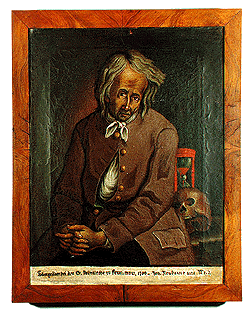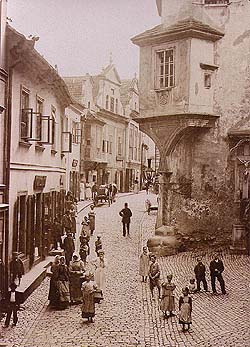Demographic Evolution of Český Krumlov
Even though the first mention of Český Krumlov comes from 1253, the number of town inhabitants was only first acknowledged in the year 1651. Only inhabitants older than 12 were on the list that was compiled then (town - 1,108 inhabitants; castle, mint, hospital, courts, mills - 442 inhabitants; Clare nun convent - 28 inhabitants). The first comprehensive census reaches us from the year 1653. There we find 2,010 people divided into the following groups: townspeople - 287 men, 325 women (612 people, 30.5% of all inhabitants), hinds: 83 men, 158 women (241 people, 12% of all inhabitants), children - 253 older than and 395 younger than 12 years (648 people, 32% of all inhabitants), tribe - 165 servants, 248 maids (413 people, 20,5% of all inhabitants), castle personnel (96 people, 5% of all inhabitants). Almost at the same time (1654) as the census, records were kept of 325 occupied and 8 deserted houses in Český Krumlov.
The increase in population in the last third of the 17th century and during the 18th century is noticeable from confessional records which, in the region of Český Krumlov, recorded the following number of confessors older than 12 years: in the year 1671 - 2,306 people, in the year 1700 - 2,508 people, in the year 1725 - 2,572 people, in the year 1751 - 2,762 people, in the year 1773 - 2,797 people.

While the slow increase in the population of Český Krumlov in
the 18th century was attributed to a natural change of inhabitants,
in the end of the 18th century and during the 19th century the
increase was influenced by the influx of country people into the
town. This wave of migration took place as a result of the Edict
for the abolition of  serfdom (1781) and
servitude (1848). While in the year 1797 only 3,483 people lived in
547 houses in Český Krumlov, in the year 1841 already 5,165 people
lived in 731 houses. Another increase in local population came
associated with the industry development of the town and its
environs in the second half of the 19th century and in the
beginning of the 20th century (1880 - 7,659 people, 739 houses;
1890 - 8,331 people, 770 houses; 1990 - 8,676 people, 764 houses;
1910 - 8,716 people, 791 houses). The rising tendency in evolution
of inhabitants of Český Krumlov culminated at the beginning of the
1920´s. In 1921 it reached its peak when 9,120 people lived here in
815 houses.
serfdom (1781) and
servitude (1848). While in the year 1797 only 3,483 people lived in
547 houses in Český Krumlov, in the year 1841 already 5,165 people
lived in 731 houses. Another increase in local population came
associated with the industry development of the town and its
environs in the second half of the 19th century and in the
beginning of the 20th century (1880 - 7,659 people, 739 houses;
1890 - 8,331 people, 770 houses; 1990 - 8,676 people, 764 houses;
1910 - 8,716 people, 791 houses). The rising tendency in evolution
of inhabitants of Český Krumlov culminated at the beginning of the
1920´s. In 1921 it reached its peak when 9,120 people lived here in
815 houses.
A subsequent decrease came in the second half of the 1920´s (1930 - 8,692 people, 1007 houses) and was then intensified due to the expulsion of the German inhabitants after the Second World War (1950 - 6,899 people, 1,172 houses). A repeated rise in the population of Český Krumlov was influenced by incorporating some of the neighbourhood villages into the town (1950 - Vyšný, 1961 - Nové Dobrkovice, Nové Spolí, Slupenec). These administrational changes caused more increases in the local population: 1950 - 8,057 (1,256 houses), 1961 - 9,255 people (1,334 houses).
The positive population evolution of Český Krumlov over the last thirty years has been influenced not only by the natural birth/death factor, but also by residential construction and subsequent immigration of people from other areas (1970 - 10,372 people, 1,367 houses; 1980 - 13,776 people - 4,626 apartments). At the last census of Český Krumlov in 1991, recorded were 14,108 people (7,014 men and 7,094 women). 3,145 (22%) people were children from age 0 to 14, 8,806 people (62.5%) were economically active people and 2,157 people (15,5%) were at post-productive age. Together with the inhabitants, there were recorded 1,564 houses in Český Krumlov which represented 5,120 apartment units (1,343 apartments in family houses).
(jg)
Further information:
Demographic
Evolution in the Český Krumlov Region
Medieval
Colonization of the Český Krumlov Region


